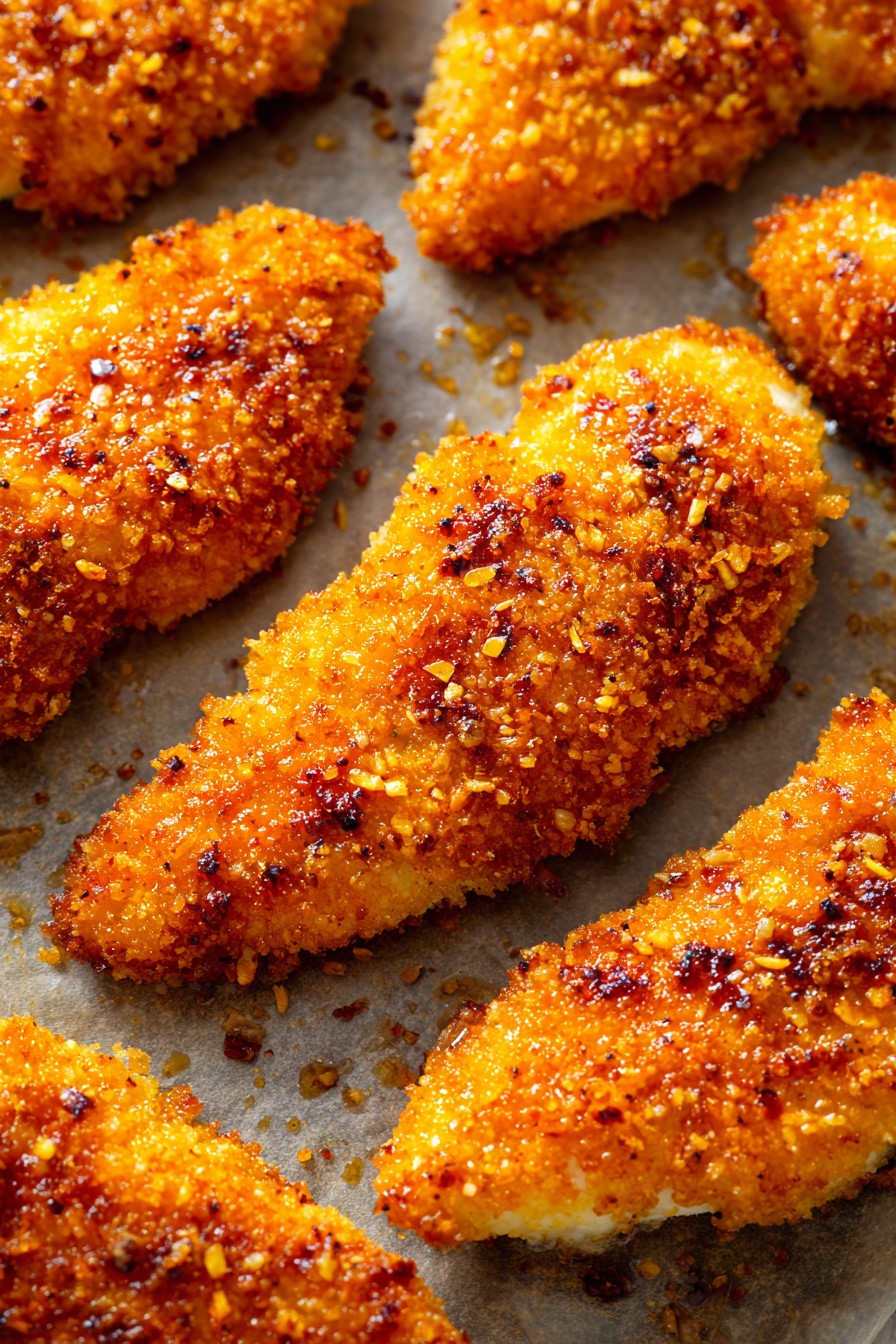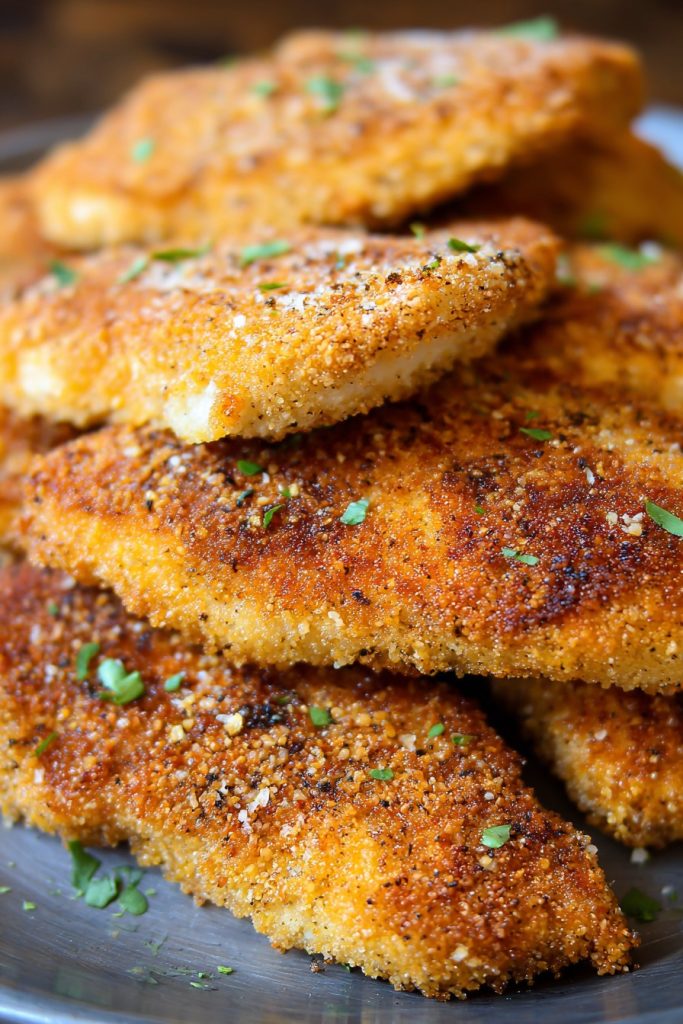Cooking frozen chicken breast directly in the air fryer saves time and delivers surprisingly moist results. This method eliminates the need for thawing while creating a perfectly cooked protein for various meals. The high-heat circulating air ensures even cooking throughout the frozen chicken.
Why This Recipe Works
- The air fryer’s rapid air circulation cooks frozen chicken evenly without requiring thawing, reducing preparation time significantly while maintaining food safety standards
- High heat creates a crisp exterior while locking in moisture, preventing the dry texture that often plagues frozen chicken preparations in conventional ovens
- Minimal oil usage results in healthier meals compared to traditional frying methods, with just enough fat to promote browning and flavor development
- Consistent results across different air fryer models make this technique reliable for weekly meal prep and last-minute dinner solutions
- Simple seasoning approach allows for customization while ensuring the chicken’s natural flavor remains the focus of the dish
Ingredients
- 4 frozen chicken breasts (6-8 ounces each)
- 2 tablespoons olive oil
- 1 teaspoon garlic powder
- 1 teaspoon paprika
- 1/2 teaspoon black pepper
- 1 teaspoon salt
Equipment Needed
- Air fryer
- Kitchen tongs
- Mixing bowl
- Measuring spoons
- Instant-read thermometer
- Cutting board
Instructions

Prepare the Seasoning Mixture
Combine olive oil, garlic powder, paprika, black pepper, and salt in a small mixing bowl. Stir thoroughly until all spices are evenly distributed throughout the oil. The oil acts as both a cooking medium and binding agent for the dry spices. Measure each ingredient precisely to maintain balanced flavor profiles. This preparation step ensures consistent seasoning application across all chicken pieces. Proper mixing prevents clumping of spices and guarantees even coating. The oil mixture should appear homogeneous before proceeding to the next step. This foundation establishes the flavor base for the entire dish.
Coat the Frozen Chicken
Remove frozen chicken breasts from packaging and pat dry with paper towels to remove surface ice crystals. Use kitchen tongs to handle the frozen chicken safely. Brush the seasoning mixture evenly over all surfaces of each chicken breast, covering both sides completely. Work systematically to ensure no areas remain unseasoned. The frozen state of the chicken actually helps the seasoning adhere better than thawed poultry. Apply moderate pressure with the brush to work the seasoning into any surface imperfections. Complete this process efficiently to prevent partial thawing during handling.
Arrange in Air Fryer Basket
Place seasoned frozen chicken breasts in a single layer within the air fryer basket, ensuring adequate space between each piece. Do not overcrowd the basket as this prevents proper air circulation. Leave at least 1/2 inch of space around each chicken breast for optimal results. Arrange thicker pieces toward the center where heat distribution is most consistent. Check that no chicken pieces touch the sides of the basket or each other. Proper arrangement is crucial for even cooking and browning. This spacing allows hot air to circulate freely around all surfaces.
Cook at High Temperature
Set air fryer to 400°F and cook for 18-22 minutes depending on thickness. Do not open the air fryer during the first 15 minutes of cooking to maintain temperature stability. The high initial temperature creates immediate surface searing that locks in moisture. Cooking time varies based on chicken thickness—thinner breasts may require less time, while thicker cuts need the full duration. Monitor through the viewing window if your model has one. The sizzling sound indicates proper cooking progress. This high-heat approach ensures food safety while achieving desirable texture.
Check Internal Temperature
Insert an instant-read thermometer into the thickest part of a chicken breast after the initial cooking time. The thermometer should register 165°F for safe consumption. If temperature reads below 160°F, continue cooking in 2-minute increments until target temperature is reached. Position the thermometer probe carefully to avoid touching bone or the air fryer basket. Allow the reading to stabilize for accurate measurement. Proper temperature verification ensures both safety and optimal texture. This step provides the definitive indicator of doneness beyond visual cues.
Rest Before Serving
Remove chicken from air fryer using tongs and transfer to a clean cutting board. Let rest for 5 minutes before slicing or serving. During this resting period, internal juices redistribute throughout the meat, resulting in more tender chicken. The residual heat continues cooking the chicken slightly, often raising the internal temperature another 5 degrees. Cover loosely with foil if desired, but avoid sealing tightly as this can create steam. This crucial step completes the cooking process and ensures optimal texture.
Slice and Serve
Slice chicken against the grain into 1/2-inch thick pieces using a sharp knife. Cutting against the grain shortens muscle fibers for more tender results. Arrange sliced chicken on plates or incorporate into your chosen dish immediately. The cooked chicken should appear white throughout with clear juices. Serve while warm for best texture and flavor. Proper slicing technique enhances the eating experience significantly. This final preparation completes the transformation from frozen protein to meal-ready component.
Tips and Tricks
For consistently better results, consider these additional techniques beyond the basic recipe. Select uniformly sized chicken breasts when possible to ensure even cooking times. If your chicken breasts vary significantly in thickness, consider pounding thicker pieces to create more consistent dimensions before freezing. When buying chicken specifically for this preparation, look for individually quick frozen (IQF) breasts as they separate more easily. For enhanced browning, lightly spray the air fryer basket with cooking oil before adding chicken, though most modern baskets are sufficiently non-stick. If your air fryer has multiple rack positions, use the middle position for most balanced heat distribution. For extra crispiness, increase temperature to 425°F during the final 3 minutes of cooking, but monitor closely to prevent burning. When cooking multiple batches, allow the air fryer to reheat fully between batches for consistent results. If your chicken develops uneven browning, rotate the basket 180 degrees halfway through cooking, though most modern air fryers circulate air sufficiently to make this unnecessary. For meal prep purposes, cooked chicken breasts can be refrigerated for up to 4 days or frozen for up to 3 months. Reheat refrigerated chicken in the air fryer at 375°F for 3-4 minutes until warmed through. For food safety, always start with properly frozen chicken that has been stored at 0°F or below and hasn’t developed freezer burn. If your chicken has ice crystals larger than 1/4 inch, consider briefly rinsing under cold water and patting dry before seasoning. For optimal texture, avoid using chicken that has been frozen longer than 6 months. When cleaning your air fryer, ensure it’s completely cool before washing to prevent damage to non-stick surfaces. For additional flavor development, consider marinating chicken before freezing, though this may slightly alter cooking times.
Recipe Variations
- Italian Herb Variation: Replace the seasoning blend with 2 tablespoons grated Parmesan cheese, 1 teaspoon dried oregano, 1 teaspoon dried basil, and 1/2 teaspoon onion powder. The cheese creates a flavorful crust while the herbs provide Mediterranean flair. This variation works particularly well for chicken destined for pasta dishes or salads.
- Spicy Southwest Style: Use 1 tablespoon chili powder, 1 teaspoon cumin, 1/2 teaspoon chipotle powder, and 1/4 teaspoon cayenne pepper for a bold flavor profile. The spice blend creates a robust crust that stands up well to salsas and avocado. Perfect for tacos, burrito bowls, or southwestern salads.
- Lemon Pepper Adaptation: Combine 2 tablespoons lemon pepper seasoning with 1 teaspoon garlic powder and 1/2 teaspoon dried thyme. The bright citrus notes complement the chicken’s natural flavor while the pepper provides subtle heat. Excellent for light summer meals or when serving with vegetable sides.
- Asian-Inspired Glaze: After cooking, brush chicken with a mixture of 2 tablespoons soy sauce, 1 tablespoon honey, 1 teaspoon sesame oil, and 1/2 teaspoon grated ginger. Return to air fryer for 1-2 minutes to set the glaze. Creates sticky, flavorful chicken ideal for rice bowls or stir-fry applications.
- Buffalo Style: Toss cooked chicken in 1/4 cup buffalo sauce mixed with 1 tablespoon melted butter. The combination of tangy heat and rich butter mimics traditional buffalo wings while maintaining healthier preparation methods. Serve with celery sticks and blue cheese dressing if desired.
Frequently Asked Questions
Can I cook frozen chicken tenders using this method?
Yes, frozen chicken tenders can be prepared using similar principles but require adjusted cooking times. Reduce cooking temperature to 380°F and cook for 12-15 minutes, checking internal temperature at the 12-minute mark. Chicken tenders have different thickness and composition compared to whole breasts, necessitating these modifications. The smaller size means they cook faster and may require less seasoning overall. Always verify doneness with a meat thermometer since visual cues can be misleading with smaller pieces.
Why does my chicken sometimes come out dry?
Dry chicken typically results from overcooking or insufficient resting time. Ensure you’re using an instant-read thermometer to check doneness precisely at 165°F, not higher. The resting period allows juices to redistribute throughout the meat rather than escaping when cut. Chicken breast thickness variations can also cause uneven cooking—consider pounding thicker areas before freezing for consistency. Using the minimum effective cooking time rather than maximum recommended time often produces juicier results.
Can I add vegetables to cook alongside the chicken?
Adding vegetables is possible but requires strategic timing. Dense vegetables like potatoes or carrots need partial cooking before adding to the basket. Lighter vegetables like broccoli or bell peppers can be added during the final 8-10 minutes of cooking. Ensure vegetables are cut uniformly and tossed with oil before adding. The moisture released by vegetables may affect chicken crispiness, so this method works best when you prioritize convenience over perfect texture.
How do I prevent the seasoning from burning during cooking?
Seasoning burn typically occurs at temperatures above 400°F or with sugar-based rubs. Stick to the recommended 400°F temperature and avoid sugar-containing seasonings. Applying seasoning evenly without clumps prevents concentrated areas that burn more easily. If using delicate herbs like basil or parsley, consider adding them after cooking rather than before. Proper oil distribution helps create a protective barrier between spices and direct heat.
Is it safe to cook chicken directly from frozen?
Cooking chicken directly from frozen is safe when using proper equipment and techniques. The air fryer’s high heat and rapid air circulation bring the chicken through the temperature danger zone quickly enough to prevent bacterial growth. Using a meat thermometer to verify the internal temperature reaches 165°F provides confirmation of safety. This method actually reduces cross-contamination risks compared to thawing in refrigerators or countertops where juices might drip onto other foods.
Summary
This air fryer frozen chicken breast method delivers juicy, perfectly cooked results without thawing. The technique saves significant preparation time while maintaining food safety standards. Consistent high heat creates desirable texture with minimal oil usage. Proper temperature verification ensures optimal doneness and safety. The approach works with various seasoning profiles for meal versatility.
Air Fryer Frozen Chicken Breast
5
servings5
minutes20
minutesIngredients
Instructions
- 1 Combine olive oil and spices in small bowl
- 2 Brush seasoning mixture onto frozen chicken breasts
- 3 Arrange chicken in single layer in air fryer basket
- 4 Cook at 400°F for 18-22 minutes
- 5 Verify internal temperature reaches 165°F
- 6 Rest for 5 minutes before slicing



